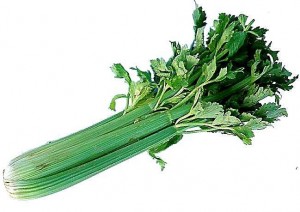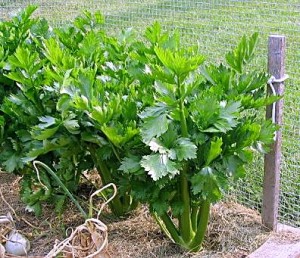 Celery (Apium graveolens) or popularly known as Kinchay in the Philippines, is a crunchy biennial plant belong in the family Apiaceae and is native to Eurasia. The plant is also related to dill, carrots, fennel, and parsley. Although originally cultivated for its perceived medicinal qualities, celery has since made the jump into the daily diets of consumers around the world.
Celery (Apium graveolens) or popularly known as Kinchay in the Philippines, is a crunchy biennial plant belong in the family Apiaceae and is native to Eurasia. The plant is also related to dill, carrots, fennel, and parsley. Although originally cultivated for its perceived medicinal qualities, celery has since made the jump into the daily diets of consumers around the world.
As a vegetable, the celery is an ideal plant, as it has many culinary and herbal uses and very little waste is associated with its use, as the entire plant is edible. The dried seeds and leaves of the celery are an excellent seasoning for many kinds of dishes. Celery can be eaten in many ways; it can be included in mixtures of roasted root vegetables, and tends to have a more rich flavor than the stalks of celery. Celery stalks are long, green, and retain their crunchy texture after brief cooking. They can be eaten raw or cooked, and are often included on crudite platters and in stir fries and soups. Raw whole celery is also used in blended green drinks. The inner ribs of the celery are said to have a beneficial effect on the heart and the circulatory system .
The low caloric content of celery makes it a popular choice for dieters, and it is also rich in vitamins K and C. Celery tastes best at the peak of the season, in the summer. When selecting celery in the store, look for white to green evenly colored specimens which are tightly clustered around the core. If the celery is being sold precut, make sure that it is not flexible or soft. If the stalks appear wilted at all, pick out another bunch of celery. The stalks should make a snapping sound when they are pulled apart. Celery can be kept refrigerated for approximately one week.
In the Philippines, celery is primarily grown in Benguet and the Mt. Province. An estimated 687 hectares is currently used for growing celery in the aforementioned locations. This crop has two varieties: the stalk variety and the Chinese variety. The stalk variety is often found in the highlands and is characterized by its thick petioles. Chinese celery variety is characterized by its strong taste and is often used in soups. Chinese celery variety is often found in lowlands or near the ocean.
How to grow Celery or Kinchay
Growing Celery
Both varieties of celery may be grown all year. However, celery may only be planted using the transplanting method. Celery likes soil that is capable of retaining moisture and so soils that have had organic compost or manure are well suited. During the hot season, celery should be planted on a seed bed one meter wide and fifteen cm high. During cold season, the seedbed should be thirty cm high. Hay may be placed over the soil to protect the seeds. This keeps the soil from getting too dry which can cause problems in the plant growth. Use of hay also prevents the seeds from being drawn off during watering. It takes two to three months before seeds grow into seedlings. At this time, seedlings may be transplanted to the plot. In transplanting, celery seedlings should be placed in two rows with rows 20cm apart and 40cm for each column.
Celery roots do not grow longer than 60 cm. Roots mostly grow 45 to 60 cm near the top of the ground. It is therefore important to use fertilizers to ensure that the crops get their needed nutrients especially when it is nearing its harvesting age.
Chicken manure may be mixed with complete fertilizer and administered 15-15-15 for every hectare. This may be followed with 150 to 200 kilos of ammonium sulfate two to three times every ten to fifteen days. Celery requires regular watering. Hay may also be used to cover soil in between the rows to keep the water from drying up as soil that is much too dry can cause lesser yield. Regular removal of weeds should also be done.
Celery is a vulnerable vegetable and needs utmost care in handling and growing. It is important to ensure that leaves do not get lesions during weeding, watering or applying insecticides. Insecticides should not be sprayed against wind direction to ensure safety.
Problems and Pests
Pests affecting celery are mostly insects like aphids, cutworms, and mites. These insects may be controlled by use of insecticides like Malathion and Sevin. It is highly important to follow the instructions on the label when using insecticides to ensure the safety of the vegetable.
New strains have helped combat much of the challenges of growing celery without toxins. Beware of slugs and snails, so put out traps.
Celery leaf spot, which shows as brown spots on the outer small leaves first before it spreads, can be avoided by checking your seedlings first before you plant and not watering the leaves. Otherwise an occasional organic fungal spray should do the trick.
Heart rot disease has mostly been bred out now, but do keep the moisture content even. Aphids and the little celery fly can sometimes visit, burrowing through the leaves, causing blisters to form. Pinch out the affected leaves and use an organic insecticide such as garlic to stop re-infestation.

Harvest and Storage
Celery has no strict or particular age for harvesting. However it is important to remember signs that indicate if the crop is ready for harvesting. Celery is ready for harvesting when it turns light green and when the leaves are lush.
Careful monitoring should be done in order to harvest celery at the right time. Lesser yield results when harvest is done too early. When done too late, celery yield may be of lesser quality.
Celery may be harvested by hand or by use of a sharp knife. Stalks should be cut near the roots to ensure that the petioles are still intact. Undesirable crops should be disposed.
Chinese celery should be harvested by removing the entire plant from the ground. Chinese celery should be harvested when it is twenty cm in height.
Return on Investment
Apart from being a constant ingredient in soups, celery is also known as a salad vegetable. The price of this vegetable varies primarily depending on its availability in the market. However, farmers gain notwithstanding its price.
Marketing
There are two ways to market celery. The first is through direct wholesale in which the crop is directly being bought from the farmer. Though this process, price of the vegetable is not directly affected by the demand in the market. The second is through retail selling in the markets or trading posts. This process allows the growers to adjust and recognize the prices according to the demand of the crop.
Production cost for growing celery is approximately Php15,000 per hectare, which can yield 160% return on investment. This is derived from a study of the Department of Agriculture, Administrative Region in the Cordilleras. With the yield of 1,300 kilos per hectare and the price of Php30 per kilo, the investment of Php15,000 yields Php24,000 net income.
Buying Tips
Celery is available year-round. Choose firm bunches that are tightly formed. The leaves should be green and crisp. Pre-packaged celery hearts contain the choice, tender, innermost ribs.
Storage Tips
Store unwashed celery in a plastic bag in the refrigerator for up to 10 days. Asian celery should be stored airtight in the refrigerator for up to one week. Leave the ribs attached to the stalk until ready to use.
Usage Tips
- Right before using, wash celery thoroughly and trim the leaves and base.
- Reserve celery leaves to use in soups, salads, stuffing and garnish.
- Prepare celery in advance by placing cut pieces in bowl of ice water up to one hour before serving.
- Add chopped celery to soups during the last 10 minutes of cooking to retain some crunch.
- Celery can be braised, steamed or boiled until just crisp-tender.
Nutrition Notes
A popular choice for dieters, the act of chewing celery actually burns more calories than it contains. Celery is also a good source of fiber and vitamins A, C and E.
Source: Carmela Abaygar, Marid Digest, Wisegeek.com; Photos: www.pccnaturalmarkets.com